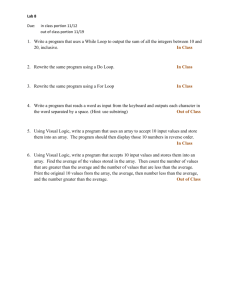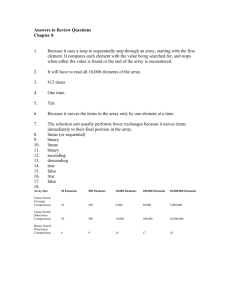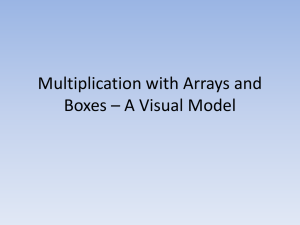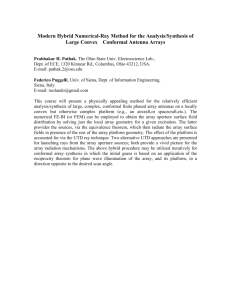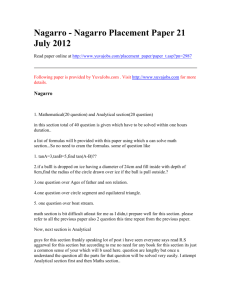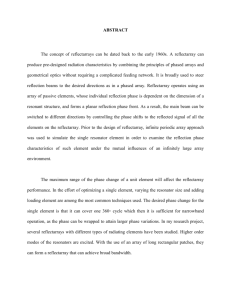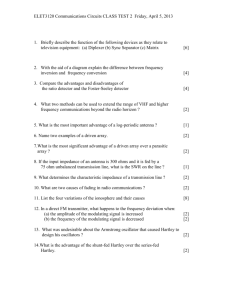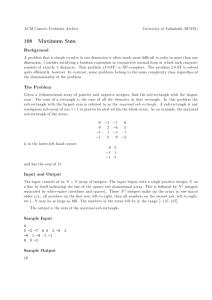Study of Conformal Antenna Array beamforming Characteristics
advertisement
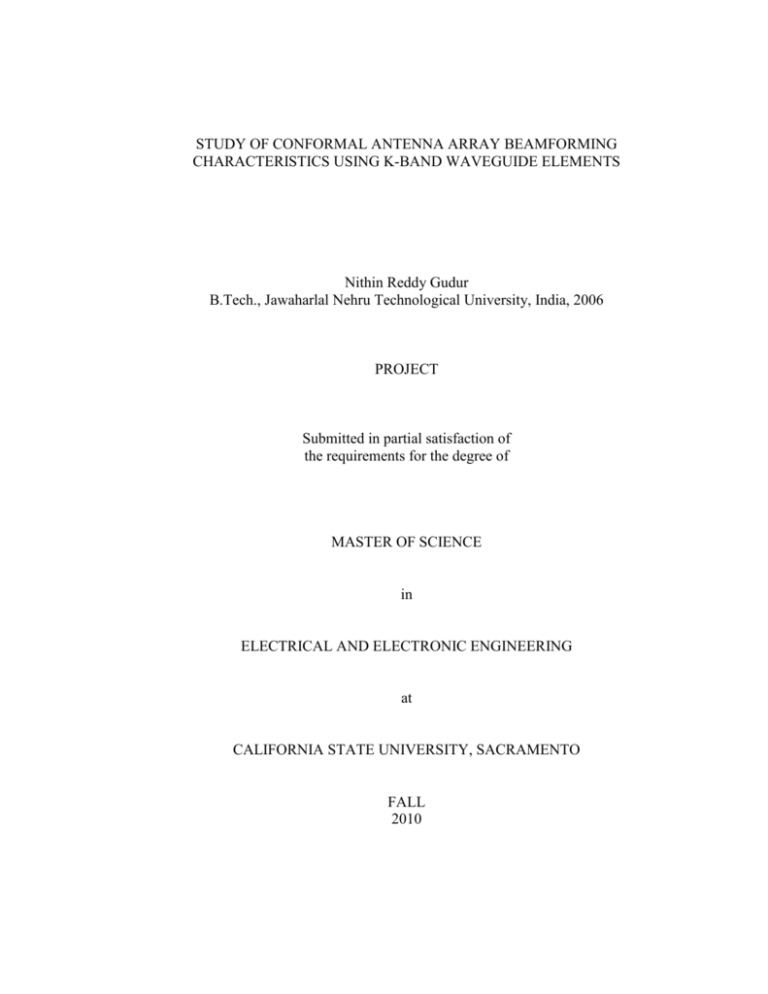
STUDY OF CONFORMAL ANTENNA ARRAY BEAMFORMING CHARACTERISTICS USING K-BAND WAVEGUIDE ELEMENTS Nithin Reddy Gudur B.Tech., Jawaharlal Nehru Technological University, India, 2006 PROJECT Submitted in partial satisfaction of the requirements for the degree of MASTER OF SCIENCE in ELECTRICAL AND ELECTRONIC ENGINEERING at CALIFORNIA STATE UNIVERSITY, SACRAMENTO FALL 2010 STUDY OF CONFORMAL ANTENNA ARRAY BEAMFORMING CHARACTERISTICS USING K-BAND WAVEGUIDE ELEMENTS A Project by Nithin Reddy Gudur Approved by: __________________________________, Committee Chair Preetham B. Kumar, Ph.D. __________________________________, Second Reader Fethi Belkhouche, Ph.D. ___________________________ Date ii Student: Nithin Reddy Gudur This is to certify that this student has met the requirements for format contained in the University format manual, and that this project is suitable for shelving in the Library and credit is to be awarded for the project. ___________________, Graduate Coordinator Preetham B. Kumar, Ph.D. Department of Electrical and Electronic Engineering iii _________________ Date Abstract of STUDY OF CONFORMAL ANTENNA ARRAY BEAMFORMING CHARACTERISTICS USING K-BAND WAVEGUIDE ELEMENTS by Nithin Reddy Gudur This project will focus on the application of advanced electromagnetic simulation software 4NEC2 for the far-field characterization of a 3-element K-band array of waveguide antenna. Previous modeling efforts have shown a significant difference between simulated and measured data. The key effort in this project will be to minimize the difference between simulated and measured data by use of the 4NEC2 software. The simulation will be carried out on both a 3-element array of open-ended waveguides. The main application of these arrays in the far-field is in satellite K-band applications, where we would require multiple beams that can be controlled in beamwidth and position. The conformal nature of the array described in this work has the ability to control the beam positions and beamwidth by adjusting the conformal nature of the array. , Committee Chair Preetham B. Kumar, Ph.D. ______________________ Date iv ACKNOWLEDGEMENT Man has made language to express his feelings. Yet, we find ourselves short of words when it comes to thanking all those who have rendered necessary help for the completion of this project. First and foremost I would like to express my gratitude and thanks to my advisor, committee chair and graduate coordinator Dr. Preetham Kumar for his expert guidance and constant support throughout this project. His openness and enthusiasm have taught me correct way of working with new technologies and has improved my knowledge of the subject. I am extremely thankful to Mr. Fethi Belkhouche, my second reader for reviewing this work and for his valuable suggestions in improving the same. It is my duty to recognize the efforts of Electrical Engineering Department and the management for creating an interactive atmosphere for learning. I would also like to take this opportunity to thank the considerate faculty and staff of Electrical and Electronics Engineering Department who have been supporting me throughout my curriculum. v TABLE OF CONTENTS Page Acknowledgement………………………………………………………………………..v List of Tables…………………………………………………………………………....vii List of Figures.…………………………………………………………………......…...viii Chapter 1. INTRODUCTION……………………………………………………………………..1 2. 4NEC2 ELECTROMAGNETIC SIMULATION SOFTWARE ……………………….….3 2.1 Introduction to 4NEC2………………………………..……………...……………..3 2.2 Additional Features of 4NEC2...................................................................................4 2.3 4NEC2 Project Flow..................................................................................................4 2.4 Configuration ……………………………………..…………………………..........5 2.5 Steps for Drawing a Geometric Model………………….………………………….6 3. DESIGN OF 3 ELEMENT K – BAND ARRAYS……………..………………...….11 3.1 K – Band Frequency Range and Applications…………………………………….11 3.2 K – Band Array Design …………..….……………………………………………14 3.3 K – Band Array Configurations …………………………………………….….....15 4. SIMULATION RESULTS FOR K - BAND WAVEGUIDE ARRAY ……...……17 4.1 Simulation Results for 3 Element Waveguide Array.............................................17 5. CONCLUSION AND FUTURE SCOPE …………………………………………….39 References……………………………………………………………………………......41 vi LIST OF TABLES Page 1. Table 3.1: Element Positions of K-band Array…………………….……………….....15 vii LIST OF FIGURES Page 1. Figure2.1: Main Window.........................................................................................6 2. Figure 2.2: Geometry Edit Window…………………………………...……..........7 3. Figure 2.3: Geometry Edit Window Showing Voltage Source at a Point..............8 4. Figure 2.4: Geometry Edit Window Showing Frequency/Ground Selection..........8 5. Figure 2.5: Geometry Edit Window Showing Conductivity/Dielectric Constant...9 6. Figure 2.6: To Calculate NEC Output Data...............…….………....……….........9 7. Figure 2.7: Window Showing Selection of Pattern…....……………..….............10 8. Figure 2.8: Window Showing Far Field pattern and its Equivalent Values……10 9. Figure 3.1: Element Horizontal………………………………...................…...…15 10. Figure 3.2: Positive Spherical Geometry...............................................................16 11. Figure 3.3: Negative Spherical Geometry……………………………………….16 12. Figure 4.1: 4NEC2 Input .nec file Showing the Simulation Parameters...............18 13. Figure 4.2: 4NEC2 3D Schematic When all Waveguide Elements are in Line....19 14. Figure 4.3: 4NEC2 Input .nec File Showing the Geometry Parameters: Array Elements are in Line....………………………………………………………..…20 15. Figure 4.4: Far-field Pattern of K-band Waveguide Array at 18GHz & phi = 0O Plane: Array Elements are in Line....………..………………………………...…21 16. Figure 4.5: Far-field pattern of K-band Waveguide Array at 18GHz & phi=90O Plane: Array Elements are in Line....………..………………………………...…22 17. Figure 4.6: 4NEC2 3D Schematic When Center Array Element (Z axis) is 2cm behind the Outer Elements..............………………………………………….....23 viii 18. Figure 4.7: 4NEC2 Input .nec File Showing the Geometry Parameters: Center Element is 2cm behind the Outer Elements...........................................................24 19. Figure 4.8: Far-field Pattern of K-band Waveguide Array at 18GHz & phi=0O Plane: Center Element is 2cm behind the Outer Elements ….……………….….25 21. Figure 4.9: Far-field Pattern of K-band Waveguide Array at 18GHz & phi=90O Plane: Center Element is 2cm behind the Outer Elements.…….………………..26 22. Figure 4.10: 4NEC2 3D Schematic When Center Array Element (Z axis) is 4cm behind the Outer Elements.....…............................................................................27 23. Figure 4.11: 4NEC2 Input .nec File Showing the Geometry Parameters: Center Element is 4cm behind the Outer Elements….......................................................28 24. Figure 4.12: Far-field Pattern of K-band Waveguide Array at 18GHz & phi = 0O Plane: Center Element is 4cm behind the Outer Elements…................................29 25. Figure 4.13: Far-field Pattern of K-band Waveguide Array at 18GHz & phi = 90O Plane: Center Element is 4cm behind the Outer Elements…................................30 26. Figure 4.14: 4NEC2 3D Schematic When Center Array Element (Z axis) is 2cm ahead of the Outer Elements.....……….……………………………………......31 27. Figure 4.15: 4NEC2 Input .nec File Showing the Geometry Parameters: Center Element is 2cm ahead of the Outer Elements........................................................32 28. Figure 4.16: Far-field Pattern of K-band Waveguide Array at 18GHz & phi=0O Plane: Center Element is 2cm ahead of the Outer Elements………………....….33 29. Figure 4.17: Far-field Pattern of K-band Waveguide Array at 18GHz & phi=90O Plane: Center Element is 2cm ahead of the Outer Elements………………...…..34 30. Figure 4.18: 4NEC2 3D Schematic When Center Array Element (Z axis) is 4cm ahead of the Outer Elements.....….........................................................................35 31. Figure 4.19: 4NEC2 Input .nec File Showing the Geometry Parameters: Center Element is 4cm ahead of the Outer Elements…....................................................36 32. Figure 4.20: Far-field Pattern of K-band Waveguide Array at 18GHz & phi = 0O Plane: Center Element is 4cm ahead of the Outer Elements….............................37 ix 33. Figure 4.21: Far-field Pattern of K-band Waveguide Array at 18GHz & phi = 90O Plane: Center Element is 4cm ahead of the Outer Elements….............................38 x 1 Chapter 1 INTRODUCTION The study of conformal microwave antenna arrays at higher frequencies is an area of great interest where considerable discussion has taken place but further data needs to be provided. It can be challenging to build an accurate model. The uses of such antennas are many and therefore acquiring data to characterize such antennas is important. In the communication field, aircraft-to-satellite and satellite-to-satellite communication requires high gain beams that can be steered over a wide area of coverage. It is proposed that a hemispherical conformal array could produce such desired characteristics [6-9]. The goals of this project were to design and accurately simulate a multielement microwave antenna array operating in the K-band frequency range (18 GHz – 26 GHz), but particularly at 18 GHz with the capability of conforming to various geometries. The effects of mutual coupling between array elements were avoided by making element spacing greater than one wavelength. The downside of avoiding mutual coupling is the grating lobes formed due to such wide element spacing. It has been shown that optimizing conformal geometry can result in controlling grating lobe levels while achieving desired field radiation coverage. Much work has been done in the study of planar microwave antenna arrays. Measurements at frequency 18 GHz have been made and documented. Such antennas have fixed element spacing in all three X-Y-Z coordinates making them planar. The 2 fixed nature of such antennas makes it easier to build arrays using many more elements than used in this research. The work performed in this project involves using linearly polarized K-band waveguide elements operating at 18 GHz. The X and Y coordinates are set in fixed positions by the mounting structure. The unique aspect of work performed in this project is the capability of the antenna array to conform to various volumetric geometries. The results of this project were positive. Certain compromises needed to be made from original design in order to achieve a working antenna array. However that was to be expected. Mathematics involved modeling an individual waveguide element, modeling the array factor for a given set of X, Y and Z coordinates, and combining the two models to arrive at a final model of the entire antenna array. The mathematical model was incorporated into 4NEC2 software environment for simulation purposes. This report is organized as follows: Chapter 1 gives a brief introduction into the array system, which is the focus of this work. Chapter 2 gives a brief introduction about 4NEC2, which is the electromagnetic simulation software used in this project and its features and functions. Chapter 3 gives a brief introduction about the K band frequency and its various applications. Chapter 4 lists the simulation results for K band array waveguides that were simulated using 4NEC2. Chapter 5 is the conclusion of this project. It also deals with the future scope of work on this project. 3 Chapter 2 4NEC2 ELECTROMAGNETIC SIMULATION SOFTWARE 2.1 Introduction to 4NEC2 The Numerical Electromagnetic code (4NEC2) is a user oriented computer code for the analysis of the electromagnetic response of antennas and other metal structures. 4NEC2 is a windows based tool for creating, viewing, optimizing and checking 2D and 3D style antenna geometry structures and generate, display and compare near-field or far-field electromagnetic patterns for both the starting and experienced antenna modeler. It was designed by Arie Voors. [12] We used 4NEC2 ver. 5.8.1 which has the following features: Graphical 2D and 3D visualization of Far- and Near-field data and Geometry structures. Drag and drop style Geometry Editor to assist the starting antenna modeler. Capable of running up to 11000 wires and/or segments (limited by the max of 2Gb of windows on-board memory) Sophisticated real-time 3D geometry and pattern viewer showing real wire-radius. Interactive Smith chart visualization for freq-sweeps. Geometry builder to create cylinder, patch, plane, box, helix and parabola shaped structures using auto-segmentation and/or equal-area rules. The user is expected to draw the structure, specify material characteristic for each object and identify ports, sources and special surface characteristics. The system then generates the necessary field solutions. The next section describes the various steps to be 4 followed in order to develop the structure, bring about the solution and analyze the same for any given structure. 2.2 Additional Features of 4NEC2 Some of the additional capabilities of the software include: Software based on the mininec code 3D patterns for both geometry and fields Extensive library of antennae Built in optimizer As mentioned above, 4NEC2 software has some extensive features related to an antenna modeling. The extensive library in 4NEC2 has several predefined functions that are available to use in the project. Also 4NEC2 has a built in optimizer which helps you in optimizing your design for the best solution. It can compare different types of patterns that are obtained as a result and decide the best among them. 2.3 4NEC2 Project Flow The main steps in creating a project in the 4NEC2 software are as follows: Configuration Drawing Source/Load Frequency 5 Environment Solution Plot 2.4 Configuration To configure 4NEC2 5.8.1, the below steps should be followed. Click 4NEC2 5.8.1 to start the design Click: File Open 4NEC2 in/output file filename (Takes you to a folder where there are many built in designs. Open any one of them) Click: Settingsselect NEC editor (new). Click: A new window will open showing all the coordinates of the geometrical structure which can be edited. If we want to model a new structure from here following steps should be followed: Click: File New Save asfilename Now, a new design interface has 3 sub-windows: Main window, geometry window and geometry edit window. 6 2.5 Steps for Drawing a Geometric Model On Windows machine Open 4NEC2 5.8.1: The main window appears as follows Figure 2.1: Main Window 7 The next step would be to draw the geometrical structure. Click Edit Input (.nec) file .The following window called geometry edit window will open: Figure 2.2: Geometry Edit Window The next step is to specify the type of source/load whether it is voltage or current and also specify the coordinates of the point where exactly we want to insert the source/load. For example if your source is voltage then following window shows the selection of voltage source: 8 Figure 2.3: Geometry Edit Window Showing Voltage Source at a Point The next step in the design is to specify the frequency/ground. The following figure shows the selection of the frequency/ground: Figure 2.4: Geometry Edit Window Showing Frequency/Ground Selection 9 If you choose real ground then you need to specify the ground type, conductivity and dielectric constant. The following figure shows that: Figure 2.5: Geometry Edit Window Showing Conductivity/Dielectric constant The next step in the design is to calculate the radiation pattern and other patterns. The following procedure is to be followed: Figure 2.6: To Calculate the NEC Output Data 10 Now if we want to get far field pattern select the far field pattern and click generate as follows: Figure 2.7: Window Showing Selection of Pattern Following results show up: Figure 2.8: Window Showing Far Field Pattern and its Equivalent Values 11 Chapter 3 DESIGN OF 3 ELEMENT K – BAND ARRAYS 3.1 K-Band Frequency Range and Applications The IEEE K band is a portion of the electromagnetic spectrum in the microwave range of frequencies ranging between 18 and 26.5 GHz is absorbed easily by water vapor (H2O resonance peak at 22.24 GHz, 1.35 cm). Subdivisions The IEEE K band is conventionally divided into three sub-bands: Ka band: K-above band, 26.5–40 GHz, mainly used for radar and experimental communications. K-band 18-26.5 GHz Ku band: K-under band, 12–18 GHz, mainly used for satellite communications, terrestrial microwave communications, and radar, especially police traffic-speed detectors. The Ku band (pronounced "kay-yoo") is a portion of the electromagnetic spectrum in the microwave range of frequencies. This symbol refers to "K-under" (in the original German, "Kurz-unten", with the same meaning) in other words, the band directly below 12 the K-band. In radar applications, it ranges from 12 to 18 GHz according to the formal definition of radar frequency band nomenclature in IEEE Standard 521-2002 [11]. Ku band is primarily used for satellite communications, most notably for fixed and broadcast services, and for specific applications such as NASA's Tracking Data Relay Satellite used for both space shuttle and ISS communications. Ku band satellites are also used for backhauls and particularly for satellite from remote locations back to a television network's studio for editing and broadcasting. The band is split into multiple segments that vary by geographical region by the International Telecommunication Union (ITU). NBC was the first television network to uplink a majority of its affiliate feeds via Ku band in 1983. Some frequencies in this radio band are used for vehicle speed detection by law enforcement, especially in Europe [11]. Advantages Compared with C-band, Ku band is not similarly restricted in power to avoid interference with terrestrial microwave systems, and the power of its uplinks and downlinks can be increased. This higher power also translates into smaller receiving dishes and points out a generalization between a satellite’s transmission and a dish’s size. As the power increases, the dish’s size can decrease. [8] This is because the purpose of the dish element of the antenna is to collect the incident waves over an area and focus them all onto the antenna's actual receiving element, mounted in front of the dish (and pointed back towards its face); if the waves are more intense, less of them need to be collected to achieve the same intensity at the receiving element. 13 The Ku band also offers a user more flexibility. A smaller dish size and a Ku band system’s freedom from terrestrial operations simplify finding a suitable dish site. For the end users Ku band is generally cheaper and enables smaller antennas (both because of the higher frequency and a more focused beam). Ku band is also less vulnerable to rain fade than the Ka band frequency spectrum. The satellite operator's Earth Station antenna do require more accurate position control when operating at Ku band than compared to C band. Position feedback accuracies are higher and the antenna may require a closed loop control system to maintain position under wind loading of the dish surface. Disadvantages: There are, however, some disadvantages of Ku band system. Especially at frequencies higher than 10 GHz in heavy rain fall areas, a noticeable degradation occurs, due to the problems caused by and proportional to the amount of rainfall (commonly known as "rain fade"). [10] This problem can be mitigated, however, by deploying an appropriate link budget strategy when designing the satellite network, and allocating a higher power consumption to compensate rain fade loss. The Ku band is not only used for television transmission, which some sources imply, but also very much for digital data transmission via satellites, and for voice/audio transmissions. 14 The higher frequency spectrum of the Ku band is particularly susceptible to signal degradation, considerably more so than C-band satellite frequency spectrum. A similar phenomenon, called "snow fade" (where snow or ice accumulation significantly alters the focal point of a dish) can also occur during winter precipitation. Also, the Ku band satellites typically require considerably more power to transmit than the C-band satellites. Under both "rain fade" and "snow fade" conditions, Ka and Ku band losses can be marginally (but significantly) reduced using super-hydrophobic Lotus effect coatings. 3.2 K-Band Array Design The antenna array structure consists of K-band open waveguide, and the array element positions, corresponding to the center of each waveguide aperture, are listed in Table 1. Each waveguide element is 19.5 cm in length with an aperture size of 4 mm x 10.5 mm, and copper wall thickness of 1 mm. Using the standard equation [1], the cutoff frequency for the dominant TE10 mode employed here was calculated to be 14.286 GHz, which is well below the operating frequencies utilized in this study. A number of beam forming applications were realized by switching among different element combinations. Additionally, axial z-axis shift of the array elements permits control of the beam width; however, such a shift also alters the shape of the array. In this paper, three different cases of the central element shift were considered: forward shift (convex surface with negative radius), no shift (planar surface with infinite radius), and backward shift (concave surface with positive radius). The central element no. 1 is 15 the focusing element of the array: axial movement of this element allows the operator to control the conformal radius of the array. Element Number X Position Y Position Z Position (cm) (cm) (cm) 1 0 0 variable 2 0 -2.5 0.0 3 0 2.5 0.0 Table 3.1: Element Positions of K-band Array 3.3 K-Band Array Configurations In this work, the horizontal configurations was studied, as illustrated in Figure 3.1. 1 2 3 Figure 3.1 - Element Horizontal geometry 16 Positive and negative geometries were considered for each of these configurations to study the bandwidth control properties of the array. A positive spherical geometry is illustrated in Figure 3.2 with its conformal sphere located in front of the antenna, while the negative spherical geometry is shown in figure 3.3, with its conformal sphere in the rear of the antenna. di R R di R-zi R-zi zi zi Figure 3.2 - Positive Spherical Geometry Figure 3.3 - Negative Spherical Geometry The parameter R represents the radius of the conformal sphere and di is the distance of the ith element from the central element, whose position is selected as the reference (0, 0, 0). The axial position of ith element is determined from the following geometrical considerations: d 2 (R z)2 R2 Or z R R2 d 2 17 Chapter 4 SIMULATION RESULTS FOR K- BAND WAVEGUIDE ARRAY This chapter details the simulations studies performed on the 3-element conformal array that was described in the previous chapter. The simulation studies were done using the 4NEC2 software. 4.1 Simulation Results for 3 Element Waveguide Array The simulation parameters are as follows: Source/Load: Voltage Source (1+j0) V Frequency of Simulation: 18 GHz Environment: Free space The schematic, the far field pattern and the resultant electric field generated using 4NEC2 software is discussed here. The relevant figures of the same are also shown below. As mentioned earlier we consider three cases of the waveguide array, one with all elements in line and the other two configurations are obtained by positioning the center element backward and forward, relative to the central focusing element. 18 The figure below shows the input simulation parameters. Figure 4.1 4NEC2 Input .nec File Showing the Simulation Parameters 19 Case 1: All the waveguide elements are in line Figure 4.2 4NEC2 3D Schematic When all Waveguide Elements are in Line The above figure 4.2 shows the 3D view of the waveguide array when all the elements are in line. 20 The input .nec file showing the geometry parameters for the simulation is shown below. Figure 4.3 4NEC2 Input .nec file Showing the Geometry Parameters: Array Elements are in Line 21 The following figure shows the far field pattern of the waveguides at phi = 0O. Figure 4.4 Far-field Pattern of K-band Waveguide Array at 18 GHz& phi = 0O Plane: Array Elements are in Line. 22 The following figure 4.5 shows the far field pattern of the waveguide array in the phi = 90O plane. Figure 4.5 Far-field Pattern of K-band Waveguide Array at 18 GHz& phi = 90O Plane: Array Elements are in Line. 23 Case 2: Center array element is 2 cm behind the other two elements Figure 4.6 4NEC2 3D Schematic When Center Array Element (Z- axis) is 2cm behind the Outer Elements. The above figure shows the 3D view of the waveguide array when center array element (Z- axis) is 2 cm behind the other two elements. 24 The input .nec file showing the parameters for the simulation is shown below. Figure 4.7 4NEC2 Input .nec File Showing the Geometry Parameters: Center Element is 2cm behind the Outer Elements The above figure of the waveguide array geometry table shows that the center array element (Z- axis) is 2 cm behind the other two elements. 25 The following figure shows the far field pattern of the waveguides at phi = 0O. Figure 4.8 Far-field Pattern of K-band Waveguide array at 18 GHz & phi = 0O Plane: Center Element is 2cm behind the Outer Elements. 26 The following figure shows the far field pattern of the waveguides at phi = 90O. Figure 4.9 Far-field Pattern of K-band Waveguide Array at 18 GHz & phi = 90O Plane: Center Element is 2cm behind the Outer Elements. 27 Case 3: Center array element is 4 cm behind the other two elements In this section the center element of the waveguide array is 4 cm behind the other two elements. The geometrical structure of the resultant configuration is shown below. Figure 4.10 4NEC2 3D Schematic When Center Array Element (Z axis) is 4cm behind the Outer Elements The above figure shows the 3D view of the waveguide array when center array element (Z- axis) is 4 cm behind the other two elements. 28 The input .nec file showing the parameters for the simulation is shown below. Figure 4.11 4NEC2 Input .nec File Showing the Geometry Parameters: Center Element is 4cm behind the Outer Elements The above figure of the waveguide array geometry table shows that the center array element (Z- axis) is 4 cm behind the other two elements. 29 The following figure shows the far field pattern of the waveguides at phi = 0O. Figure 4.12 Far-field Pattern of K-band Waveguide Array at 18GHz & phi = 0O Plane: Center Element is 4cm behind the Outer Elements 30 The following figure shows the far field pattern of the waveguides at phi = 90O. Figure 4.13 Far-field Pattern of K-band Waveguide Array at 18GHz & phi = 90O Plane: Center Element is 4cm behind the Outer Elements 31 Case 4: Center array element is 2 cm ahead of the other two elements Figure 4.14 4NEC2 3D Schematic When Center Array Element (Z axis) is 2cm ahead of the Outer Elements The above figure shows the 3D view of the waveguide array when the center array element is 2 cm ahead of the other two elements 32 The input .nec file showing the parameters for the simulation is shown below. Figure 4.15 4NEC2 input .nec File Showing the Geometry Parameters: Center Element is 2cm ahead of the Outer Elements The above figure of the waveguide array geometry table shows that the center array element (Z- axis) is 2 cm ahead of the other two elements. 33 The following figure shows the far field pattern of the waveguides at phi = 0O. Figure 4.16 Far-field Pattern of K-band Waveguide Array at 18GHz & phi=0O Plane: Center Element is 2cm ahead of the Outer Elements 34 The following figure shows the far field pattern of the waveguides at phi = 90O. Figure 4.17 Far-field Pattern of K-band Waveguide Array at 18GHz & phi=90O Plane: Center Element is 2cm ahead of the Outer Elements 35 Case 5: Center array element is 4 cm ahead of the other two elements In this section the center element of the waveguide array is 4 cm in front of the other two elements. The geometrical structure of the resultant configuration is shown below. Figure 4.18 4NEC2 3D Schematic When Center Array Element (Z axis) is 4cm ahead of the Outer Elements. The above figure shows the 3D view of the waveguide array when center array element is 4cm ahead of the other two elements. 36 The input .nec file showing the parameters for the simulation is shown below. Figure 4.19 4NEC2 Input .nec File Showing the Geometry Parameters: Center Element is 4cm ahead of the Outer Elements The above figure of the waveguide array geometry table shows that the center array element (Z- axis) is 4 cm ahead of the other two elements. 37 The following figure shows the far field pattern of the waveguides at phi = 0O. Figure 4.20 Far-field Pattern of K-band Waveguide Array at 18GHz & phi = 0O Plane: Center Element is 4cm ahead of the Outer Elements 38 The following figure shows the far field pattern of the waveguides at phi = 90O. Figure 4.21 Far-field Pattern of K-band Waveguide Array at 18GHz & phi = 90O Plane: Center Element is 4cm ahead of the Outer Elements 39 Chapter 5 CONCLUSION AND FUTURE SCOPE This project has succeeded in presenting several items. First a working K-Band antenna array operating at 18 GHz with the ability to conform to various geometries was designed and secondly, a software simulation package was created in the 4NEC2 environment which has been proven to successfully model actual antenna performance for any given set of parameters. Lastly data is shown for 3 – element horizontal antenna array configurations, for a range of conformal geometries, which include both positive and negative geometry configurations of the array. This data has been summarized and discussed. The general results show that for severe conformal geometries with small radii, field radiation pattern is more focused. The field radiation pattern is stronger as the center, =0, is approached. As conformal geometry becomes more planar, spherical or circular radii approach infinity, the field radiation patterns broaden out and become more uniform over the 180 scanning range. Although grating lobes were present in field radiation patterns they did not become overpowering and would not hamper antenna performance. The results of this project were positive. Certain compromises needed to be made from original design in order to achieve a working antenna array. However that was to be expected. Mathematics involved modeling an individual waveguide element, modeling 40 the array factor for a given set of X, Y and Z coordinates, and combining the two models to arrive at a final model of the entire antenna array. The mathematical model was incorporated into 4NEC2 software environment for simulation purposes. Future work would focus on the design of other linear antenna array configurations such as a vertical array, or even a planar array configuration, and to test the radiation properties of these array configurations. The ultimate use of the array is to control the beam position and beam width by use of the conformal geometry, and study the effectives of positive and negative conformal array surfaces. 41 REFERENCES [1] Robert J. Mailloux, John F. McIlvenna, and Nicholas P. Kernweis, “Microstrip Array Technology”, IEEE Transactions on Antennas and Propagation, January 1981, Volume AP-29, Number 1, pages 25-35. [2] Morton, T.E.; Pasala, K.M., ‘Performance analysis of conformal conical arrays for airborne vehicles’, IEEE Transactions on Aerospace and Electronic Systems, Volume 42, Issue 3, July 2006 Page(s):876 – 890. [3] G.D. Hopkins, D.L. Sherman, K.P. Pullen, R. Zagrodnick, ‘A K-band microstrip phased array radiator for airborne antennas’, Proceedings of the 2004 IEEE Aerospace Conference, March 2004, Volume: 2, pp.897 – 904. [4] G. Caille; E. Vourch; M.J. Martin; J.R. Mosig; M. Polegre, Conformal array antenna for observation platforms in low Earth orbit, IEEE Antennas and Propagation Magazine, Volume 44, Issue 3, June 2002 Page(s):103 – 104. [5] L.C. Godara, “Applications of Antenna Arrays to Mobile Communications, Part I: Performance Improvement, Feasibility, and System Considerations”, Proceedings of the IEEE, July 1997, Volume 85, Number 7, pages 1031-1056. [6] T.S.M. Maclean, Principles of Antennas: Wire and Aperture, Cambridge University Press, 1986, pages 244-247. [7] Constantine A. Balanis, Antenna Theory: Analysis and Design, Harper and Row Publishers Inc., 1982, pages 204-228, 235-243. 42 [8] David M. Pozar, Microwave Engineering, Addison-Wesley Publishing Company, 1990, pages 141-153, 716. [9] Lal C. Godara, “Applications of Antenna Arrays to Mobile Communications, Part I: Performance Improvement, Feasibility, and System Considerations”, Proceedings of the IEEE, July 1997, Volume 85, Number 7, pages 1031-1056. [10] David M. Pozar, “Beam Transmission of Ultra Short Waves: An Introduction to the Classic Paper by H. Yagi”, Proceedings of the IEEE, November 1997, Volume 85, Number 11, pages 1857-1862. [11] http://en.wikipedia.org/wiki/Ku_band [Ku band] [12] http://home.ict.nl/~arivoors/ [NEC based antenna modeler and optimizer by Arie Voors]
